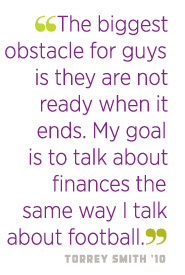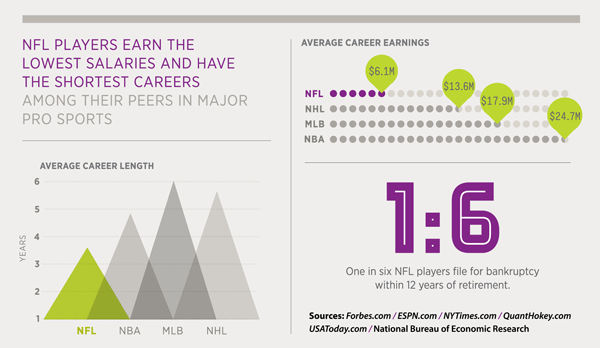- May 08, 2015
- By Liam Farrell
During a lifetime spent as a football player, Vaughn Parker always knew what to do: Get faster and stronger; protect the quarterback; line up and hit the man across the line of scrimmage.
What he wasn’t ready for was the day when there was no one left to push, pull or wrestle to the ground.
A second-round NFL draft pick in 1994, the 6-3, 300-pound tackle had been a core offensive player for the San Diego Chargers. But after tearing knee ligaments in 2003 and spending half a season with the Washington Redskins, playing in just one game, he decided it was time to walk away.
Yet without the rigors and routine of football, Parker found himself without a purpose. Oh my God, what do I do with myself? he thought. The recession sank his once-successful ventures in real estate, he gained a significant amount of weight, and he eventually separated from his wife.

“I didn’t call it depression, but that’s what it was,” he says. “Even though I was doing the real estate stuff, I was still in that fog. There was a lot of activity. I’m just not sure how productive I was.”
After his lost decade, Parker is trying to get back on track. And on a chilly day in March, that meant joining several other current and former NFL players to scrutinize a wall of spatulas.
They formed an unlikely huddle amid the crowds at the NFL Consumer Products Summit in Houston’s George R. Brown Convention Center. Their goal was to come up with an innovative way to market “homegating,” or bringing the stadium tailgate experience into living rooms across the country.
It was just one part of the second consumer products “boot camp” organized by UMD’s Robert H. Smith School of Business and the National Football League, a four-day crash course meant to give athletes a guide to finding their lives’ second act.
Participants attended seminars on the fundamentals of business planning, budgeting and marketing and listened to presentations from successful companies like ’47 Brand clothing and New Era. Men who spent years grappling with terminology like “cover one,” “A-gap” and “65 Toss Power Trap” now dived into defective allowances, gross margin requirements and EDLP (everyday low price). Besides the homegating team, a second group had to research women’s apparel, and both presented their ideas to a panel of judges.
Toby Egan, an associate professor at the School of Public Policy and senior executive fellow at the Smith School, says the program gives players a foundation to pursue a career in selling more than just NFL merchandise.
“We hope to give them a developmental mindset, not only about consumer products, but about themselves,” he says. “We hope that they leave with a solid starter package and a really good social network.”
Dollars and Sense
The modern NFL is undeniably a success. Revenues are reportedly nearing $10 billion a year, and NFL games accounted for 45 of the 50 most-watched shows last fall. Super Bowl XLIX in February drew the biggest audience in U.S. television history, 114.4 million people.
But one of the most persistent questions underlying the league is whether players have truly shared its achievements. Labor strife has been common throughout the NFL’s history, and even now, with the advantages of free agency and the steady drumbeat of large contracts being signed each spring, skepticism remains.
A few factors get most of the blame, starting with the unique crush-and-smash physicality of football. One of the most popular football books of recent vintage, former Denver Bronco Nate Jackson’s “Slow Getting Up: A Story of NFL Survival from the Bottom of the Pile,” details a world where the real struggle involves ligaments and bones more than Xs and Os.
Contracts rarely include much guaranteed money, and the annual roster cuts from 90 players at the start of training camp to 53 at the start of the season leave a large population of men whose NFL “careers” consist only of practices.
And those who actually make a team have the chance, and often feel the pressure, to chase an opulent lifestyle, as stories of NFL players burning through money on nightlife binges, fancy cars and houses and spurious investments formed the core of ESPN’s documentary “Broke.” An April study published by the National Bureau of Economic Research found that nearly one in six NFL players file for bankruptcy within 12 years of retirement.
“Having played for a long time and been well-paid does not provide much protection against the risk of going bankrupt,” the study says.
The NFL is making an effort to create a healthy pipeline for the inevitable post-football life. In addition to the consumer products boot camp, NFL Player Engagement (motto: Prep, Life, Next) runs programs on topics such as business management, the hospitality industry, and sports journalism and communications.
Torrey Smith ’10 heard the horror stories and has taken advantage of these resources, attending the inaugural consumer products boot camp last year in Baltimore. Smith, a wide receiver now playing for the San Francisco 49ers, is also working on an M.B.A. at the University of Miami.
“The biggest obstacle for guys is they are not ready when it ends,” he says. “My goal is to talk about finances the same way I talk about football.”
Learning Fundamentals
In a conference room of the Hyatt Regency in downtown Houston, Hank Boyd, a clinical associate professor at the Smith School, takes the boot camp participants through the basics of product marketing.
Take the example of a pair of torn, distressed jeans, he says. Why would someone buy them? Who is the target customer? What is the difference between a customer won on “value” versus a customer won on “satisfaction”?
“One of the cool things, if you can pull it off, is to predict where demand is going to be,” Boyd says. “This is what it is all about. We are in the prediction game.”
In the audience is David Quessenberry, whose NFL career might be over before it even starts. It’s not a question of work ethic. Quessenberry graduated high school without any athletics scholarship offers, but he went from a walk-on to an all-conference offensive lineman at San Jose State. In 2013, he was drafted by the Houston Texans.
Yet Quessenberry missed his entire rookie year with a broken foot. Then he was diagnosed with lymphoma, and lost his second season to a regimen of chemotherapy and radiation.
Now in remission, the tackle hopes to play for the Texans in the fall. But Quessenberry is here to prepare for when football is no longer an option.
“I just want to keep everything in front of me,” he says.
Players say few athletes have the same mindset as Quessenberry while trying to hold onto their jobs on the field. And that can pose big problems.
In “Is There Life After Football?: Surviving the NFL,” sociologists James Holstein and Richard Jones wrote about the significant challenges for players who “are immersed in a cultural, structural, psychological and experiential world that insulates them from many mundane aspects of everyday life.”
Retirement, they wrote, is rarely a clean process with an orchestrated announcement to a roomful of reporters. Instead, it is often the final step in an unceremonious decline involving injury, contract renegotiations and lonely workouts in the hopes of making another team. As those opportunities dry up, a player finds himself at the end of a career when most people are still working toward the prime of their occupations. Identity—as well as employment—is at stake.
“It’s not just their jobs that disappear,” Holstein and Jones say.
The priority for Charles Way, a former New York Giants fullback and the head of NFL player engagement, is getting more current players like Quessenberry into these educational workshops. Exploring a new career, he says, is better done before a helmet and pads are taken off for good.
“You are under the gun (when you retire),” he says. “It’s easier when you are playing.”
New Expectations
At the start of camp, Vaughn, Quessenberry and their teammates had nothing but a market category and seemingly endless options to bring to a panel of judges. But amidst the sea of NFL-branded beer cozies, slow cookers and cell phone chargers that they saw at the products summit, a new thought was borne: How about combining all this stuff into a package for fans? What about something like the Birchbox beauty product subscription service, but for football parties?
Ken Jones, founder of Fusion Ventures and an entrepreneur-in-residence at the Dingman Center for Entrepreneurship in the Smith School, told them it was a great idea.
“If you guys seriously did this, I would (invest),” he said the day before the presentations. “You are opening up a new channel.”
For $26, the team told the judges, you can get a standard box with items like disposable plates and cups; for $30, you can get one with ’47 Brand clothing and a coupon; for $40, you can get a premium box with a gift like a beer stein.
Live near your team? Pick it up at a grocery store. Live in another state? Just go online and order the franchise of your choice. And, in the era of social media, teams can encourage fans to post pictures of their parties and give tickets to a winner each week.
The atmosphere in the pitch room, a meeting space at the headquarters of Academy Sports + Outdoors in Katy, Texas, wasn’t quite cutthroat, but the players earned praise for how far they got in just four days. Boyd reminded all the participants of a quote from Booker T. Washington: “An ounce of application is worth a ton of abstraction.”
The “Super Box” team prevailed over their rivals, who used the enthusiastic, if slightly off-key, vocal stylings of three-time Super Bowl champion Henry Lawrence to pitch a gift registry for female fans. More important to Parker, though, was the fact that an academic exercise ultimately wasn’t meant to be academic: He had spent four days with experts who have new expectations of his future.
“It’s been awesome,” he says. “They want you to take this and do something with it.” TERP
